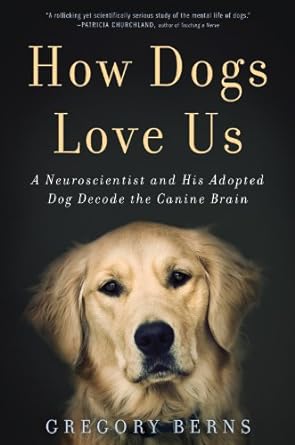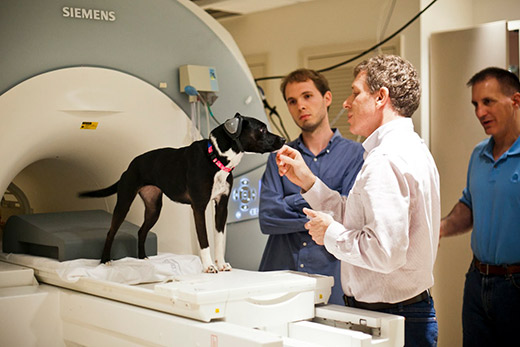
How Dogs Love Us answers the age-old question of dog lovers everywhere: What is my dog thinking?
And it gets there with a well-told, heart-warming, fascinating story that starts with the author’s desire to understand what was going on in the brain of his own dog, Callie—an adopted shy, skinny terrier mix. As a neuroscientist, Berns had spent decades using MRI imaging technology to study how the human brain works; why not try using the same technology on dogs?
For one thing, no one had ever been able to get a dog to undergo an MRI scan without sedation or restraint. But sedating the dog would make it impossible for Berns to study the brain activity that could help answer his questions, and restraining the dog would result in anxiety and distress for the dog. Berns believed that all subjects of scientific study—not just humans—must be willing participants. Humans must sign a consent form, something a dog cannot do. Berns wanted a dog to enter willingly into the activities that would allow fMRI (functional magnetic resonance) imaging studies of their brains; the dog’s behavior would indicate consent. In keeping with his determination to conduct the studies in an ethical way, Berns insisted that if the dog changed its mind and hopped out of the MRI, the study would stop.
Despite the initial naysayers (including most of his colleagues), Berns reasoned that if the military could train dogs to operate calmly in some of the loudest, most chaotic, and dangerous environments, there must be a way to train dogs to sit in an MRI scanner.
And so, led by Berns and his small, hand-picked team of researchers, he and Callie worked together to overcome the behavioral, technical, and legal challenges of capturing the inner workings of the canine brain.

Photo courtesy of Emory University Photo Video/Bryan Meltz
The results are fascinating, and mark a major milestone in the study of dog cognition, including how dogs empathize with human emotions, and how they love us. It’s a joyous look at why dogs and humans share “one of the most remarkable friendships in the animal kingdom.”
If you’re thinking, “this book sounds like too much science for me to enjoy,” let me assure you: How Dogs Love Us is a page-turner (I couldn’t put it down). It reads like a thriller/mystery, well-told memoir/love-story, with plenty of laughs along the way. It is a tribute to scientific study, as well as a testament to the truth that many already hold dear: Dogs should be treated as we would treat our best human friends, “with love, respect, and appreciation for their social and emotional intelligence.”

Note: How Dogs Love Us was initially published in hardcover in 2013. A paperback edition was published in 2022. Somehow, it escaped my radar; I came across it one day at the local library when I was perusing the aisles—yet another reason I love libraries.
Another note for Audible fans: I like to read books off a printed page—not on a screen. I like to hold the book in my hands, turn the pages, admire the production qualities, and so on. I have rarely listened to an audio version of a book; as a writer, I like to see the words on the page, which is a different experience for my brain (for every brain, according to researchers), than hearing them. While writers enjoy reading a good book the same way any reader does, we are also—without even thinking about it—examining sentence structure, word choice, paragraph breaks, even punctuation as we read. That kind of “reading like a writer” is not possible when listening to a book.
And so, I was really delighted to have a conversation today about How Dogs Love Us with my favorite landscaper/paralegal/nonfiction writer friend, Greg, whose taste in books has led me to many good reads. He wanted me to know how much he is enjoying listening to the book. “The narrator does a terrific job,” he told me, something that is “not always the case,” he said. Like me, he finds the story to be a page-turner, although he is not turning the pages. “It reads like a mystery thriller,” he said. He’s reluctant to hit pause, and always eager to return to where he left off listening. Kudos to LJ Ganser, the voice on Audible delivering this fascinating tale.

About The Author, Gregory Berns:
Gregory Berns, M.D., Ph.D., is the Distinguished Professor of Neuroeconomics at Emory University. His research has been featured in The New York Times, The Wall Street Journal, Time Magazine, National Geographic, Smithsonian, The Los Angeles Times, Nature, New Scientist, and Psychology Today. He has appeared on 60 Minutes, GMA, CNN, NPR, ABC, and the BBC.
How Dogs Love Us was a New York Times and Wall Street Journal bestseller. He has written other books about dogs, including What It’s Like to Be a Dog, which was named one of the 10 best science books of 2017 by the Smithsonian. He lives in Atlanta, Georgia.
